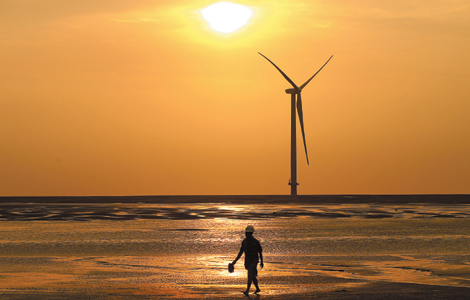Solution to growth of new-energy firms blowing in the wind
Updated: 2013-09-18 10:40
By Jiang Xueqing (China Daily)
|
||||||||
 |
|
A wind farm at Rudong in Jiangsu province. China's installed wind power capacity had reached almost 63 million kilowatts by the end of 2012. Xu Congjun / for China Daily |
Green development is facing a series of obstacles, as Jiang Xueqing reports in Changchun.
 |
The act was introduced with the aim of promoting the use of non-fossil fuel energy. However, the companies, which include wind farms and biomass energy plants, are also suffering huge financial losses.
From January to July, Huaneng Taobei Wind Farm in Baicheng, Jilin province, generated 134.75 million kilowatt-hours of wind power. During the same period, it lost 72.48 million kWh of unused wind power, resulting in a loss of almost 40 million yuan ($6.5 million).
The wind farm's average annual utilization hours, the time during which it is running at full capacity, reached just 1,425 hours in 2012, but its break-even figure is about 1,560 hours.
During the first half of 2013, the farm averaged 813 utilization hours - the lowest in the country - and it is likely to continue to lose money, chief engineer Zhang Weilong says.
The farm's owner, China Huaneng Group, is debating whether to begin construction of the fourth phase. The previous three phases cost between 1.3 and 1.4 billion yuan.
Chen Xin, manager of the wind farm's pre-project department, speaking at a media event, said, "We'd rather put the project on hold, as the more wind turbines we build, the more money we lose."
The company's losses were caused by an oversupply of electricity in Jilin. Although the province had a total installed power capacity of 26 million kilowatts in 2012, the maximum demand for power was just 8.6 million kw.
"Several years ago, when the provincial government officials were making plans for the development of heating measures during winter, they didn't leave any room for the growth of new energy," said Zheng Jianlin, deputy director of the Jilin provincial energy bureau.
Jilin province's installed power capacity doubled in the period 2006 to 2010, from roughly 10 million kw to more than 20 million. During that period, the local government encouraged State-owned enterprises to build a large number of thermal power plants in the province to boost the growth of gross domestic product, but failed to take the provincial demand for electricity into account. It will take three to five years to adjust the discrepancy between supply and demand, said Zheng.
One solution would be to use long-distance transmission lines to deliver surplus wind power from the west of Jilin, where wind resources are rich, to regions where energy consumption is high.
 |
- New-energy vehicle policy shifts gears
- New energy summit takes place in Chengdu
- Sino-French co-op in new energy
- New energy vehicles await fuel injection
- Low charge in new-energy initiative
- Is wind power running out of puff?
- China to focus on developing biomass, solar power
- SOEs dominate China's wind power projects
- China tops world in wind power, hydropower capacity
- Exhibition Special: The world's wind power industry gathers in Beijing
Most Viewed
Editor's Picks

|

|

|

|

|

|
Today's Top News
Gun control debate gathers little steam
China supports US-Russia deal on Syria
Trending news across China on Sept 18
China-US key to global future: report
EU ready for talks with China on investment pact
All's fare as apps take roads to upgrades
Space station to open for foreigners
Fine-particle pollution climbs in August: report
US Weekly

|

|













